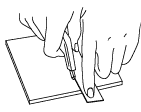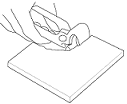Ceramic wall tiles - cutting
general tile cutting - straight tile cuts - irregular tile cuts
Cutting ceramic wall tiles - general:
The vast majority of tiles have some form of pattern, this may not always be easy to recognise as the pattern may appear to be random - very few are truly random.
The pattern should always be used to establish a common 'way up' - do not use the impression on the back of the tiles as a guide - these are not always consistent.
Before marking a tile to cut, ensure that it is orientated so that the pattern is the same way up as the others.
Generally, thicker tiles are harder to cut than thinner tiles - you can expect more failures when cutting thicker tiles,
Hiring 'professional' cutting equipment from the tool hire shop will improve your cutting success rate.
Use a pencil or crayon to mark cut lines on tiles, avoid felt tipped markers as the ink will discolour the grout when applied.
Take care when handling cut tiles as the cut edges will be sharp.
Straight cuts
Achieving straight cuts on most ceramic tiles can be achieved using simple tools, often, all that are needed are a handheld tile cutter (or scribe) and a steel straight edge to guide the cutter.
Measuring tiles for cutting
Once the final row of full sized tiles have been applied, the space for each part tile should be measured individually, don't assume that the distance between a wall, ceiling or skirting board etc and a row of full tiles will be uniform - the distance will vary.
To measure each tile for cutting, make sure that the pattern is up the right way vertically and then place the tile glaze side down against the adjacent full tile and slide it up to the edge to be tiled leaving a gap of about a 3mm (1/8 inch) for grouting all around.
Mark both sides of the tile to be cut where it lines up with the edge of the existing tile underneath using a pencil or crayon.
Cutting the tile
 With
both edges of the tile marked, place a steel straight edge on the glazed, front surface of the tile and line it up with the pencil marks.
With
both edges of the tile marked, place a steel straight edge on the glazed, front surface of the tile and line it up with the pencil marks.
Using a handheld tile cutter (aka scribe), score the glaze using one strong pull across the face of the tile.
 Place
the scored tile (glazed side up) on a flat, solid surface and place a match stick under each end under the scored line.
Place
the scored tile (glazed side up) on a flat, solid surface and place a match stick under each end under the scored line.
Place a hand on each side of the tile and apply firm downwards pressure, this will break the tile along the scored line.
Alternatively, use a tile cutting machine - (this can be an attractive alternative where there are a large number of tiles to be cut), be careful when selecting manual tile cutting machines as some cheaper models do not work very well but cause broken tiles. Most Tool Hire Shops will offer professional type tile cutters machines which can be better than cheap machines sold for the DIY'er.
Making irregular cuts
Cutting tiles to irregular shapes is harder than making straight cuts and requires the use of a special tile saw and/or tile nippers. There is no need to accurately cut complicated shapes, filling in around the edge of tiles with grout will provide a satisfactory finish.
Tile Saw:
 A
tile saw consists of a frame holding the ends of a tile cutting blade (the blade is circular in section with cutting edges all the way round) - it looks similar to a hack saw.
A
tile saw consists of a frame holding the ends of a tile cutting blade (the blade is circular in section with cutting edges all the way round) - it looks similar to a hack saw.
To avoid damage to the glazing on the tile, always use a tile saw from the glazed side of the tiles and cut the tile on the down stroke of the blade.
Tile nibblers:
 Tile nibblers are hand tools which removes small pieces of tile when the handles are squeezed together - they are like a pair of woodworking pinchers but with toughened cutting edges.
Tile nibblers are hand tools which removes small pieces of tile when the handles are squeezed together - they are like a pair of woodworking pinchers but with toughened cutting edges.
Don't try to make too large a cut with nibblers at one time, it is better to nibble away small pieces to slowly shape the tile.
Typical irregular shapes.
Cutting a corner.
To cut a tile so that it fits around a corner, measure the position of the corner after the last full tile has been positioned on both sides of the corner.
Take the two measurements from the edge of the corner to the last full tiles by positioning the tile (glazed side up) against the edge of the fixed tile on one side of the corner and marking the glaze, then do the same on the other side of the corner.
With the corner marked on the two edges of the tile, allow a further 3mm (1/8 inch) (to accommodate the grout) and draw lines on the glaze to establish the outline of the corner on the tile.
 Method 1 (probably the safest).
Method 1 (probably the safest).
Use a tile saw to cut along the shortest edge of the corner from the edge of the tile to the turn.
Then make the second (longer) cut with the tile saw from the edge of the tile to meet the first saw cut.
Method 2 (quicker but increased risk of going wrong).
Cut the longest side of the corner from the edge of the tile to the right-angle using a tile saw.
Score the glaze using a straight edge and a handheld tile cutter from the end of the saw cut to the edge of the tile to form the shortest side of the corner.
Firmly hold the tile on a flat surface with the score line over a sharp edge, then sharply knock down on the waste piece of tile - it should break off along the scored line.
A curved out of the corner.
 Where the corner of a tile needs to be removed so that it will fit around other than a straight edged corner, mark the shape required on the tile allowing for at least a 3mm (1/8 inch) gap between the profile of the obstruction and the profile of the finished tile.
Where the corner of a tile needs to be removed so that it will fit around other than a straight edged corner, mark the shape required on the tile allowing for at least a 3mm (1/8 inch) gap between the profile of the obstruction and the profile of the finished tile.
First remove most of the waste by using a handheld tile cutter with a straight edge to score the glaze with the longest possible straight line on the waste. Place the tile firmly on a flat surface (glaze side up) with the score line over a sharp edge, sharply knock downwards on the waste piece - it should break off along the scored line.
Now use tile nibblers to slowly remove the remaining waste in small pieces - it may help to score the finial required profile on the glaze using a handheld tile cutter but this will require a steady hand.
Holes for pipes.
 When a pipe will come within a tile, the best method is to cut the hole from the edge of the tile.
When a pipe will come within a tile, the best method is to cut the hole from the edge of the tile.
Mark the position of the pipe on the tile after the tile below has been positioned. Place the tile (glazed side up) on the top of fixed tile, against the side of the pipe, allow for the vertical adjustment for the tile spacing and mark the vertical the centre of the pipe on the tile. Mark the horizontal centre of the pipe on the tile by moving it under the pipe and lined up with the fixed tile below.
From the marks of the pipe centre on the two edges, draw lines on the glaze to show the centre of the pipe on the tile. Then draw a circle at least 6mm (1/4 inch) bigger on the tile (the additional size will allow for the grouting).
Draw a line from each side of the circle at right angles to the nearest tile edge - this will form the area of tile to be removed.
Use a tile saw to cut along one of the lines from the tile edge to the edge of the marked circle. Then cut the tile along the other line from the tile edge.
Use a handheld tile cutter to score the glaze between the two inner ends of the cuts, put a match stick under the score mark and a sharp tap of the centre off-cut will detach it from the tile. You may want to use this off cut to 'plug' the hole when the tile is fitted, in this case, you will need to use a tile saw to remove the semicircle on the inner end.
Finish off by using a tile saw to cut out the remaining semicircle of waste tile.
Note:
It is sometimes suggested that to fit a tile around a pipe, the tile is cut along the centre line of the pipe and a half circle cut out of each part tile then the two parts are fitted around the pipe from each side. This method does not really work as although it will fit around the pipe, accurately joining along the scored line is impossible and there will not be enough space for grouting along the join.
Irregular edges.
 You
have to decide how close to an irregular edge you want to trim a tile - this will often depend upon how visible the tile will be. If the tile edge will be very visible, you may decide to make an elaborate cut to the tile instead of making a simpler cut and filling the space with grout.
You
have to decide how close to an irregular edge you want to trim a tile - this will often depend upon how visible the tile will be. If the tile edge will be very visible, you may decide to make an elaborate cut to the tile instead of making a simpler cut and filling the space with grout.
To cut an irregular edge, the method is basically the same as for removing a curved piece out of a corner of a tile (above):
- First draw the profile required on the front of the tile,
- Then cut off most of the waste by using a straight edge and handheld tile cutter,
and - Finally, nibble away the tile until the required profile is obtained.
